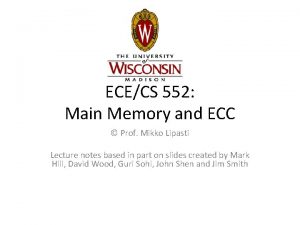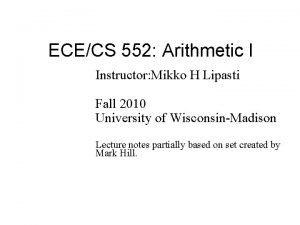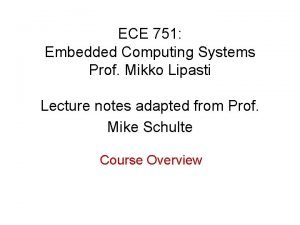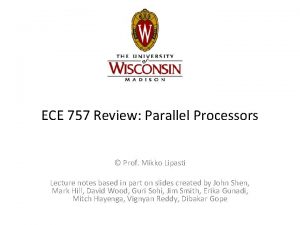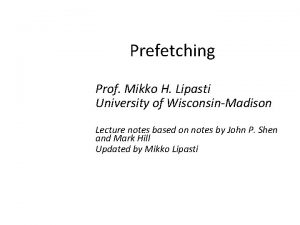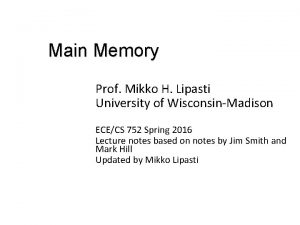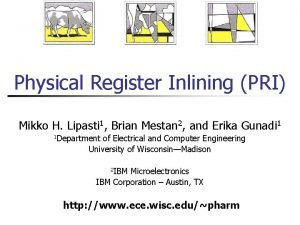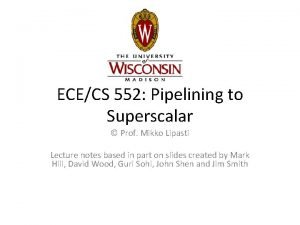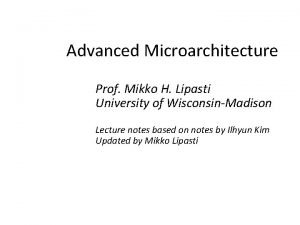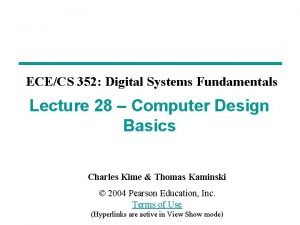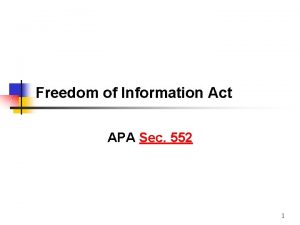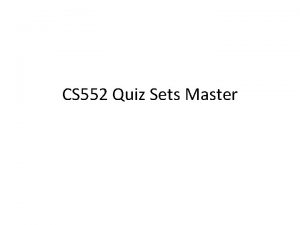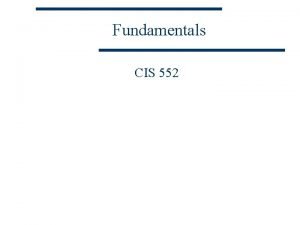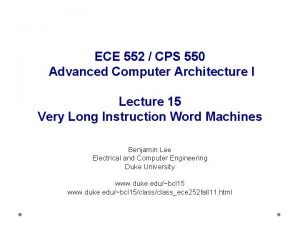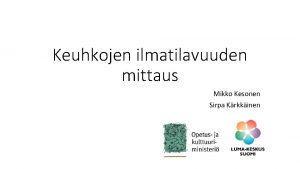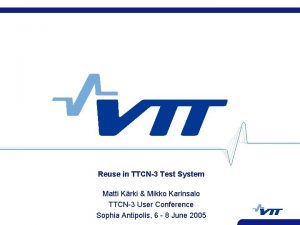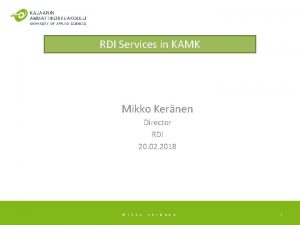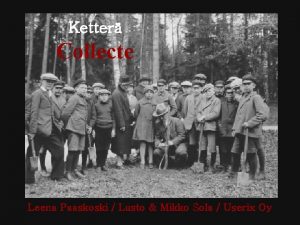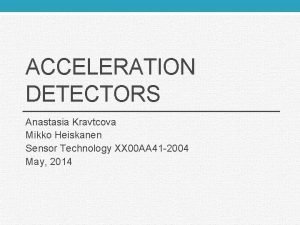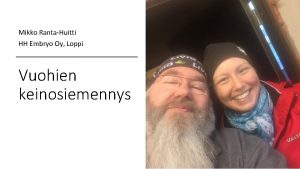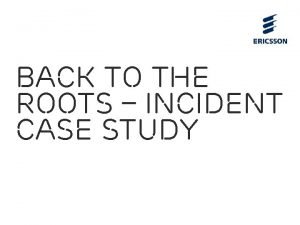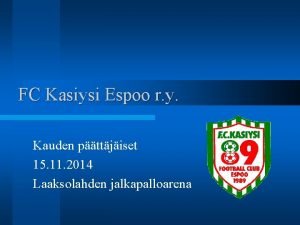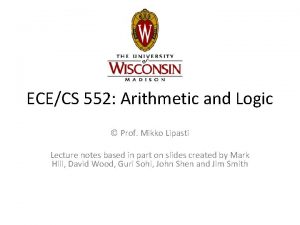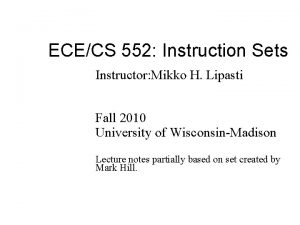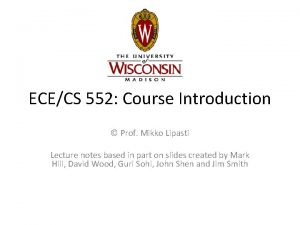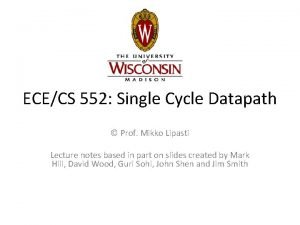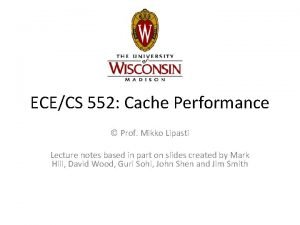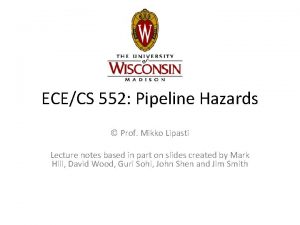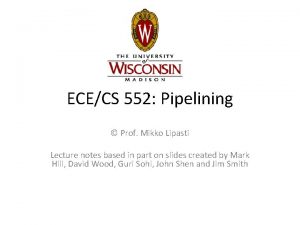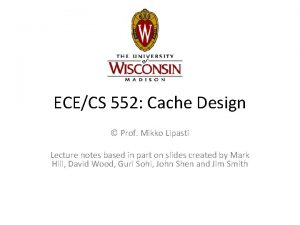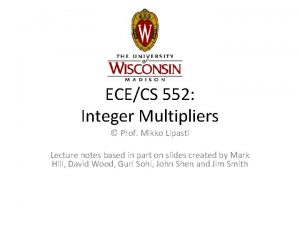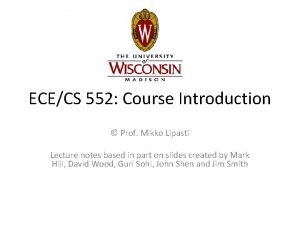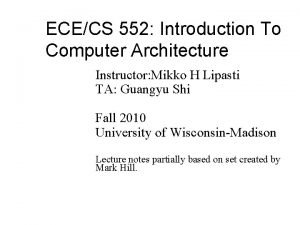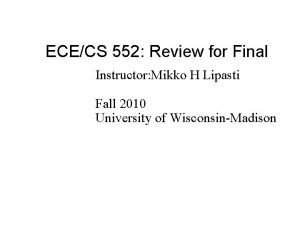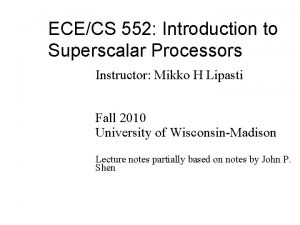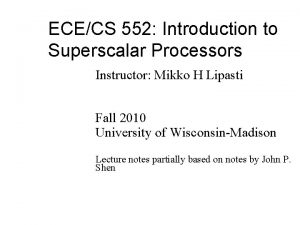ECECS 552 Arithmetic II Instructor Mikko H Lipasti





![16 -bit Array Multiplier [Source: J. Hayes, Univ. of Michigan] l l Conceptually straightforward 16 -bit Array Multiplier [Source: J. Hayes, Univ. of Michigan] l l Conceptually straightforward](https://slidetodoc.com/presentation_image/38592e5573b1fc8cae18e83f87f52b30/image-6.jpg)







































- Slides: 45

ECE/CS 552: Arithmetic II Instructor: Mikko H Lipasti Fall 2010 University of Wisconsin-Madison Lecture notes created by Mikko Lipasti partially based on notes by Mark Hill

Basic Arithmetic and the ALU l Earlier in the semester l Number representations, 2’s complement, unsigned l Addition/Subtraction l Add/Sub ALU l Full adder, ripple carry, subtraction l Carry-lookahead addition l Logical operations l and, or, xor, nor, shifts l Overflow 2

Basic Arithmetic and the ALU l Now – Integer multiplication l Booth’s algorithm – Integer division l Restoring, non-restoring – Floating point representation – Floating point addition, multiplication l These are not crucial for the project 3

Multiplication l Flashback to 3 rd grade – – l Multiplier Multiplicand Partial products Final sum Base 10: 8 x 9 = 72 – PP: 8 + 0 + 64 = 72 l How wide is the result? 1 0 0 0 x 1 0 0 1 1 0 0 0 1 0 0 0 – log(n x m) = log(n) + log(m) – 32 b x 32 b = 64 b result 4

Array Multiplier 1 0 0 0 x 1 0 0 1 l Adding all partial products simultaneously using an array of basic cells 1 0 0 0 0 Sin Cin Ai Bj 0 0 1 0 0 0 Cout (C) 2008 -2009 by Yu Hen Hu Ai , Bj Full Adder Sout 5
![16 bit Array Multiplier Source J Hayes Univ of Michigan l l Conceptually straightforward 16 -bit Array Multiplier [Source: J. Hayes, Univ. of Michigan] l l Conceptually straightforward](https://slidetodoc.com/presentation_image/38592e5573b1fc8cae18e83f87f52b30/image-6.jpg)
16 -bit Array Multiplier [Source: J. Hayes, Univ. of Michigan] l l Conceptually straightforward Fairly expensive hardware, integer multiplies relatively rare l Mostly used in array address calc: replace with shifts 6

Instead: Multicycle Multipliers l Combinational multipliers – Very hardware-intensive – Integer multiply relatively rare – Not the right place to spend resources l Multicycle multipliers – Iterate through bits of multiplier – Conditionally add shifted multiplicand 7

1 0 0 0 Multiplier x 1 0 0 1 1 0 0 0 1 0 0 0 8

Multiplier 1 0 0 0 x 1 0 0 1 1 0 0 0 1 0 0 0 9

Multiplier Improvements l Do we really need a 64 -bit adder? – No, since low-order bits are not involved – Hence, just use a 32 -bit adder l l Shift product register right on every step Do we really need a separate multiplier register? – No, since low-order bits of 64 -bit product are initially unused – Hence, just store multiplier there initially 10

1 0 0 0 Multiplier x 1 0 0 1 1 0 0 0 1 0 0 0 11

Multiplier 1 0 0 0 x 1 0 0 1 1 0 0 0 1 0 0 0 12

Signed Multiplication l Recall – For p = a x b, if a<0 or b<0, then p < 0 – If a<0 and b<0, then p > 0 – Hence sign(p) = sign(a) xor sign(b) l Hence – Convert multiplier, multiplicand to positive number with (n-1) bits – Multiply positive numbers – Compute sign, convert product accordingly l Or, – Perform sign-extension on shifts for prev. design – Right answer falls out 13

Booth’s Encoding l Recall grade school trick – When multiplying by 9: l l Multiply by 10 (easy, just shift digits left) Subtract once – E. g. l l l 123454 x 9 = 123454 x (10 – 1) = 1234540 – 123454 Converts addition of six partial products to one shift and one subtraction Booth’s algorithm applies same principle – Except no ‘ 9’ in binary, just ‘ 1’ and ‘ 0’ – So, it’s actually easier! 14

Booth’s Encoding l Search for a run of ‘ 1’ bits in the multiplier – E. g. ‘ 0110’ has a run of 2 ‘ 1’ bits in the middle – Multiplying by ‘ 0110’ (6 in decimal) is equivalent to multiplying by 8 and subtracting twice, since 6 x m = (8 – 2) x m = 8 m – 2 m l Hence, iterate right to left and: – Subtract multiplicand from product at first ‘ 1’ – Add multiplicand to product after last ‘ 1’ – Don’t do either for ‘ 1’ bits in the middle 15

Booth’s Algorithm Current Bit to bit right Explanation Example Operation 1 0 Begins run of ‘ 1’ 00001111000 Subtract 1 1 Middle of run of ‘ 1’ 00001111000 Nothing 0 1 End of a run of ‘ 1’ 00001111000 Add 0 0 Middle of a run of ‘ 0’ 00001111000 Nothing 16

Booth’s Encoding l Really just a new way to encode numbers – Normally positionally weighted as 2 n – With Booth, each position has a sign bit – Can be extended to multiple bits 0 1 +1 0 +2 1 -1 -2 0 0 Binary 1 -bit Booth 2 -bit Booth 17

2 -bits/cycle Booth Multiplier l For every pair of multiplier bits – If Booth’s encoding is ‘-2’ l Shift multiplicand left by 1, then subtract – If Booth’s encoding is ‘-1’ l Subtract – If Booth’s encoding is ‘ 0’ l Do nothing – If Booth’s encoding is ‘ 1’ l Add – If Booth’s encoding is ‘ 2’ l Shift multiplicand left by 1, then add 18

1 bit Booth 2 bits/cycle Booth’s Current Previous Operation 00 +0 01 +M; 10 -M; 11 +0 Explanation 00 0 +0; shift 2 [00] => +0, [00] => +0; 2 x(+0)+(+0)=+0 00 1 +M; shift 2 [00] => +0, [01] => +M; 2 x(+0)+(+M)=+M 01 0 +M; shift 2 [01] => +M, [10] => -M; 2 x(+M)+(-M)=+M 01 1 +2 M; shift 2 [01] => +M, [11] => +0; 2 x(+M)+(+0)=+2 M 10 0 -2 M; shift 2 [10] => -M, [00] => +0; 2 x(-M)+(+0)=-2 M 10 1 -M; shift 2 [10] => -M, [01] => +M; 2 x(-M)+(+M)=-M 11 0 -M; shift 2 [11] => +0, [10] => -M; 2 x(+0)+(-M)=-M 11 1 +0; shift 2 [11] => +0, [11] => +0; 2 x(+0)+(+0)=+0 19

Booth’s Example l Negative multiplicand: -6 x 6 = -36 1010 x 0110, 0110 in Booth’s encoding is +0 -0 Hence: 1111 1010 x 0 0000 1111 0100 x – 1 0000 1110 1000 x 0 0000 1101 0000 x +1 1101 0000 Final Sum: 1101 1100 (-36) 20

Booth’s Example l Negative multiplier: -6 x -2 = 12 1010 x 1110, 1110 in Booth’s encoding is 00 -0 Hence: 1111 1010 x 0 0000 1111 0100 x – 1 0000 1110 1000 x 0 0000 1101 0000 x 0 0000 Final Sum: 0000 1100 (12) 21

Integer Division l Again, back to 3 rd grade (74 ÷ 8 = 9 rem 2) Divisor 1 0 0 1 Quotient 0 1 0 Dividend 0 1 0 0 1 - 1 0 0 0 - 1 0 1 0 1 0 0 0 1 0 Remainder 22

Integer Division l How does hardware know if division fits? – Condition: if remainder ≥ divisor – Use subtraction: (remainder – divisor) ≥ 0 l OK, so if it fits, what do we do? – Remaindern+1 = Remaindern – divisor l What if it doesn’t fit? – Have to restore original remainder l Called restoring division 23

Integer Division 1 0 0 1 Quotient Divisor 1 0 0 0 1 0 1 0 Dividend - 1 0 0 0 1 0 1 1 0 - 1 0 0 0 1 0 Remainder 24

1 0 0 1 Quotient Divisor Integer Division 1 0 0 0 1 0 1 0 Dividend - 1 0 0 0 1 0 1 1 0 - 1 0 0 0 1 0 Remainder 25

Division Improvements l Skip first subtract – Can’t shift ‘ 1’ into quotient anyway – Hence shift first, then subtract l l Undo extra shift at end Hardware similar to multiplier – Can store quotient in remainder register – Only need 32 b ALU l Shift remainder left vs. divisor right 26

Improved Divider 27

Improved Divider 28

Further Improvements l Division still takes: – 2 ALU cycles per bit position 1 to check for divisibility (subtract) l One to restore (if needed) l l Can reduce to 1 cycle per bit – Called non-restoring division – Avoids restore of remainder when test fails 29

Non-restoring Division l Consider remainder to be restored: Ri = Ri-1 – d < 0 – Since Ri is negative, we must restore it, right? – Well, maybe not. Consider next step i+1: Ri+1 = 2 x (Ri) – d = 2 x (Ri – d) + d l Hence, we can compute Ri+1 by not restoring Ri, and adding d instead of subtracting d – Same value for Ri+1 results l Throughput of 1 bit per cycle 30

NR Division Example Iteration 0 1 2 3 4 Step Initial values Shift rem left 1 2: Rem = Rem - Div 3 b: Rem < 0 (add next), sll 0 2: Rem = Rem + Div 3 a: Rem > 0 (sub next), sll 1 Rem = Rem – Div Rem > 0 (sub next), sll 1 Shift Rem right by 1 Divisor 0010 0010 0010 Remainder 0000 0111 0000 1110 1101 1100 1111 1000 0001 1000 0011 0001 0010 0011 0001 0011 31

Floating Point l Want to represent larger range of numbers – Fixed point (integer): -2 n-1 … (2 n-1 – 1) How? Sacrifice precision for range by providing exponent to shift relative weight of each bit position l Similar to scientific notation: l 3. 14159 x 1023 l Cannot specify every discrete value in the range, but can span much larger range 32

Floating Point l Still use a fixed number of bits – Sign bit S, exponent E, significand F – Value: (-1)S x F x 2 E l IEEE 754 standard Single precision S E F Size Exponent Significand Range 32 b 8 b 23 b 2 x 10+/-38 11 b 52 b 2 x 10+/-308 Double precision 64 b 33

Floating Point Exponent specified in biased or excess notation l Why? l – To simplify sorting – Sign bit is MSB to ease sorting – 2’s complement exponent: Large numbers have positive exponent l Small numbers have negative exponent l – Sorting does not follow naturally 34

Excess or Biased Exponent -127 -126 … +127 l 2’s Compl 1000 0001 1000 0010 … 0111 1111 Excess-127 0000 0001 … 1111 1110 Value: (-1)S x F x 2(E-bias) – SP: bias is 127 – DP: bias is 1023 35

Floating Point Normalization l S, E, F representation allows more than one representation for a particular value, e. g. 1. 0 x 105 = 0. 1 x 106 = 10. 0 x 104 – This makes comparison operations difficult – Prefer to have a single representation l Hence, normalize by convention: – Only one digit to the left of the floating point – In binary, that digit must be a 1 l l Since leading ‘ 1’ is implicit, no need to store it Hence, obtain one extra bit of precision for free 36

FP Overflow/Underflow l FP Overflow – Analogous to integer overflow – Result is too big to represent – Means exponent is too big l FP Underflow – Result is too small to represent – Means exponent is too small (too negative) l Both can raise an exception under IEEE 754 37

IEEE 754 Special Cases Single Precision Double Precision Value Exponent Significand 0 0 0 nonzero denormalized 1 -254 anything 1 -2046 anything fp number 255 0 2047 0 infinity 255 nonzero 2047 nonzero Na. N (Not a Number) 38

FP Rounding l Rounding is important – Small errors accumulate over billions of ops l FP rounding hardware helps – Compute extra guard bit beyond 23/52 bits – Further, compute additional round bit beyond that l Multiply may result in leading 0 bit, normalize shifts guard bit into product, leaving round bit for rounding – Finally, keep sticky bit that is set whenever ‘ 1’ bits are “lost” to the right l Differentiates between 0. 5 and 0. 5000001 39

Floating Point Addition l Just like grade school – First, align decimal points – Then, add significands – Finally, normalize result l Example 9. 997 x 102 9. 997000 x 102 4. 631 x 10 -1 0. 004631 x 102 Sum 10. 001631 x 102 Normalized 1. 0001631 x 103 40

FP Adder 41

FP Multiplication l l Sign: Ps = As xor Bs Exponent: PE = AE + BE – Due to bias/excess, must subtract bias e = e 1 + e 2 E = e + 1023 = e 1 + e 2 + 1023 E = (E 1 – 1023) + (E 2 – 1023) + 1023 E = E 1 + E 2 – 1023 l Significand: PF = AF x BF – Standard integer multiply (23 b or 52 b + g/r/s bits) – Use Wallace tree of CSAs to sum partial products 42

FP Multiplication Compute sign, exponent, significand l Normalize l – Shift left, right by 1 Check for overflow, underflow l Round l Normalize again (if necessary) l 43

Summary l Integer multiply – Combinational – Multicycle – Booth’s algorithm l Integer divide – Multicycle restoring – Non-restoring 44

Summary l Floating point representation – Normalization – Overflow, underflow – Rounding Floating point add l Floating point multiply l 45
 Mikko lipasti
Mikko lipasti Mikko h. lipasti
Mikko h. lipasti Mikko h. lipasti
Mikko h. lipasti Mikko h. lipasti
Mikko h. lipasti Ece 751
Ece 751 Mikko lipasti
Mikko lipasti Mikko h. lipasti
Mikko h. lipasti Mikko h. lipasti
Mikko h. lipasti Mikko lipasti
Mikko lipasti Pri register
Pri register Mikko lipasti
Mikko lipasti Mikko lipasti
Mikko lipasti Ececs
Ececs Sec 552
Sec 552 Cs 552
Cs 552 +1 (617) 552-2015
+1 (617) 552-2015 Cis 552
Cis 552 Ece 552
Ece 552 Resguardos fijos
Resguardos fijos Ece 552
Ece 552 Omd 552 hospital waste management
Omd 552 hospital waste management Private lipasti
Private lipasti Mikko kesonen
Mikko kesonen System by mikko
System by mikko Mikko ulander
Mikko ulander Mikko juusela
Mikko juusela Mikko vienonen
Mikko vienonen Mikko bentlin
Mikko bentlin Mikko keränen kamk
Mikko keränen kamk Mikko posti
Mikko posti Mikko lindeman
Mikko lindeman Mikko manka tampereen yliopisto
Mikko manka tampereen yliopisto Modulaarinen tuotekehitys
Modulaarinen tuotekehitys Tietovirtakaavio
Tietovirtakaavio Mikko saastamoinen
Mikko saastamoinen Mikko mäkelä metropolia
Mikko mäkelä metropolia Mikko häikiö
Mikko häikiö Mikko tiira
Mikko tiira Mikko karppinen
Mikko karppinen Potentiometric accelerometer
Potentiometric accelerometer Hh embryo
Hh embryo Mikko routala
Mikko routala Mikko karikytö
Mikko karikytö Mikko ranta njs
Mikko ranta njs Joannaseppa
Joannaseppa Mikko nieminen
Mikko nieminen
